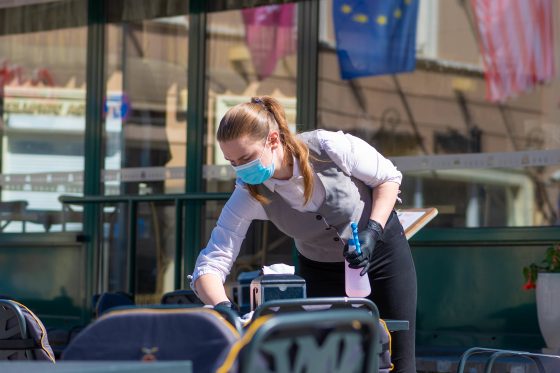Kudos to B.C.’s businesses for working hard to plan and implement safety controls that protect workers and the public from COVID-19 transmission.

Photo credit: iStock.com/Michele Ursi
In May, the B.C. government implemented its phased approach for reopening B.C. businesses. WorkSafeBC supported this approach by developing industry-specific protocols to help businesses return to operations safely.
Kelly Mean, an occupational safety officer with WorkSafeBC, has been visiting mini-malls in Surrey, checking in with clothing stores, delis, coffee shops, restaurants, hair stylists, dentists, and other businesses that opened during Phase 2 of B.C.’s Restart Plan.
“We’ve been really happy with the work put in by employers,” Kelly says. “Almost every one we’ve visited has some controls in place to protect both their workers and the public.”
She adds that everyone is addressing the physical distancing requirements either by limiting the number of people allowed in or by making space for their workers to stand so they don’t have to cross over each other. Some businesses also have directional markers on the floor that help keep people separated.
During the visits with employers, Kelly and the two other safety officers she’s partnered with will chat with workers and employers — while maintaining physical distance, of course — and answer their questions. For example, some employers are asking what to do if they have a customer who refuses to wear a mask in the store as requested.
Kelly says: “I advise employers that it’s their right to ask people without masks not to shop at their store or not to come in for a hair cut. Sometimes the limiting factor in keeping workers safe is the customer not following rules.”
Each workplace requires a COVID-19 Safety Plan
All employers — whether they are reopening their business or they never closed — are required to develop a COVID-19 Safety Plan that outlines their protocol and procedures. While a number of the employers Kelly visited haven’t yet completed this safety plan in written form, many have controls in place, including having policies on handwashing, sanitizing frequently touched surfaces, and offering personal protective equipment to their workers.
After the health and safety visit and inspection, the occupational safety officers send each employer a report, which may include details about what the employer can work on. They also send additional information and resources, such as this COVID-19 Safety Plan template. (It’s not mandatory to use this template, as long as the required information is provided in writing.)
“We provide employers with information and then we follow up at a later date to ensure that they implemented some more concrete controls,” Kelly says, adding that she encourages all employers to reach out if they need any assistance. “Give us a call and we can answer your questions. We have all kinds of resources that are being updated constantly.”
If you have questions, you can call WorkSafeBC’s Prevention Information Line at: 1.888.621.7233. Also see Returning to safe operation frequently asked questions and Inspections during the COVID-19 pandemic: Frequently asked questions for employers.
Thank you to everyone — all employers, workers, and safety officers — for doing your part to keep people safe. #LetsDoOurPartBC



is there any guidelines on self temperature checking before entering the work place? ie; instructions sanitization after use.
we will be using a non-contact infrared thermometers.
When it comes to temperature checks, not everyone thinks it’s an effective way to determine if someone has Covid, since people can be asymptomatic. Here’s some information about non-contact temperature assessment devices from the U.S. Food and Drug Administration.